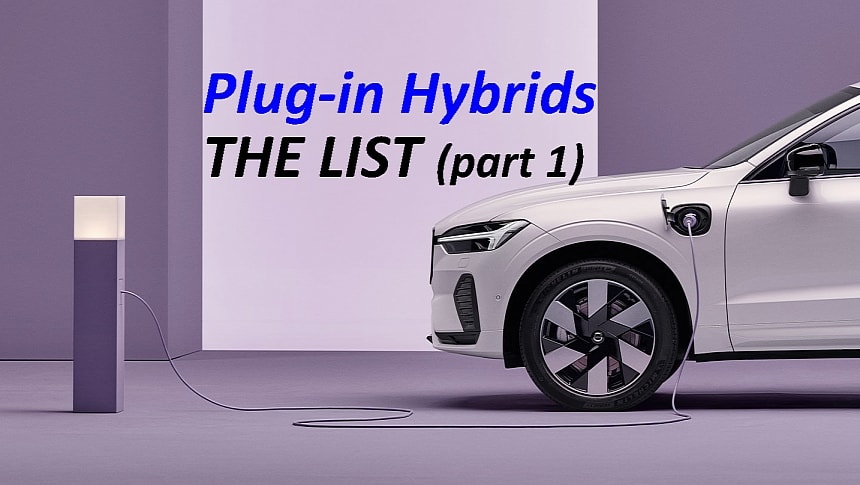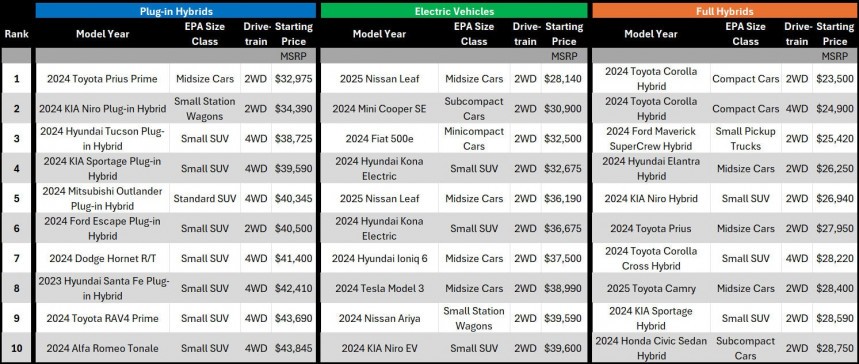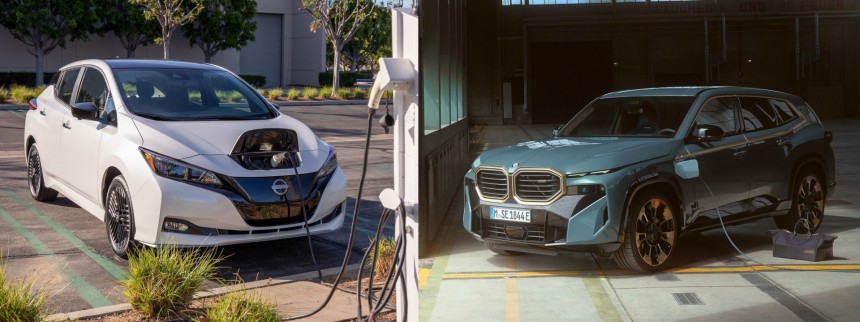My electrohead motto is "The electric light did not come from the continuous improvement of candles." That's why I think it's wrong to consider hybrid powertrains, especially plug-in hybrids, a natural evolution to fully electric vehicles. Nevertheless, they are an interesting option, and this list might help you choose the right plug-in hybrid car for your needs.
In a previous article, I explained why labeling plug-in hybrid cars as PHEVs (Plug-in Hybrid Electric Vehicles) is wrong. They indeed allow usage in electric-only mode (with its share of limitations). Still, their powertrains are based on internal combustion engines, while the electric motors and the battery are mainly sidekicks.
Interestingly, I noticed most US manufacturers silently shifted their labeling from the very popular PHEV moniker to the more complex but technically accurate "plug-in hybrid" formula.
Well, I think this is because the car industry finds a "ladder" of hybrid designations more useful: micro-hybrid, mild-hybrid, full-hybrid, and plug-in hybrid. The next step is electric, of course—and this is how popular wisdom concludes that hybrids are the necessary steps to embrace EVs sometime in the future…
Excuse my slightly conspirational-ish digress; let's get back to the facts, shall we? It's a rhetorical question because the nation is preparing for Trumpism's impact, which we all know favors conspiracies and anti-EV propaganda. However, it's the plug-in hybrids we must focus on now, not the politics.
Interestingly, 19 brands sell plug-in hybrids in the US, more than double the eight that sell full hybrids. That's because many carmakers in the first category preferred the so-called mild-hybrid powertrains instead of full-hybrid ones. Unexpectedly, many more carmakers sell fully electric vehicles: 29 of them!
The last statistic is that 37 models use hybrid powertrains at this point, slightly less than the 41 using plug-in hybrid ones. Once again, fully electric models are in greater number – 65, double that of hybrids and a third more than plug-in hybrids.
We're yet to see the sales chart for the first half of 2024, but in the first quarter, we witnessed a sharp decrease in electric vehicles, while hybrids and plug-in hybrids are on the rise. However, pay attention to details: analysts consider mild hybrids as proper hybrids, so the "Americans prefer hybrids more than EVs" is flawed.
Nevertheless, plug-in hybrids have already passed a 2% share of the entire car market, so let's examine what makes these powertrains attractive to prospective customers. First, I should note that they are perceived more as an alternative to electric cars, not full hybrids or gas cars.
Secondly, I excluded plug-in hybrids with MSRP starting prices of more than $250,000 from the list. If you're willing to pay more than a quarter of a million for a car, I doubt you'll do it because of the powertrain type. Like in the EVs' list case, such expensive cars are irrelevant to this analysis.
Now, the average starting price for the 50 plug-in hybrid models and variants in this list is around $86,000. This is ten grand more than the average for the 154 fully electric variants considered in a previous article and almost double the average for the 55 full-hybrid variants.
You should also know that in July 2024, the average price for new cars in the US was estimated to be almost $50,000. As I showed you on another occasion, Americans don't buy cheap new cars: the ten best-selling new vehicles in 2023 had an average basic price of more than $35,000, accounting for a quarter of the new car market.
So, at first, plug-in hybrids are pretty expensive, but remember that value was only an average for the whole list. If we consider only cars costing no more than $100,000, plug-in hybrids' average starting price drops to around $58,000, while EVs result a little higher, at around $61,000. The value for full hybrids is much lower at $40,000.
The first conclusion is that plug-in hybrids are priced similarly to their battery-electric contenders. Depending on a series of factors, both categories benefit from governmental incentives, so the average price values drop to around $55,000—very close to the average for the whole new car market, right?
Here's one more piece of information regarding prices, this time for the Top 10 most affordable plug-in hybrids and fully electric vehicles, respectively. As you can see in the table below, all EVs cost less than $40,000, while half of the plug-in hybrids' prices are more than that value:
Also, you can notice that almost all plug-in hybrids are 4WD small SUVs, while most of those affordable EVs are 2WD cars. I don't see why carmakers would bother to make less costly plug-in hybrids when you can choose very affordable full-hybrid models, right?
A clearer difference comes from the drivetrain type: while 70% of EVs have all-wheel drive, that percentage is 90% for plug-in hybrids. By comparison, only 60% of full hybrid variants are offered with AWD.
As the plug-in hybrid powertrain is expensive, it's only logical to add all-wheel drive to it because $1,500-2,000 doesn't make a huge difference for a $50-60,000 car. Besides, most plug-in hybrids are SUVs, and many SUV customers choose all-wheel drive variants. So, carmakers rarely bother offering front or rear-wheel drive variants for these powertrains.
But let's focus on the main advertised trait of a plug-in hybrid vehicle: you can use it as a zero-emission electric vehicle on a daily basis while the long journeys range anxiety is out of the picture thanks to the internal combustion engine and the fuel tank you can rapidly fill up anywhere in the country.
There are three metrics EPA provides to give you an idea of a plug-in hybrid vehicle's fuel and/or electricity consumption:
a. MPGe (miles per gallon of gasoline-equivalent): It gives you the equivalent for the fuel consumption when the car is used in EV drive only, with no help from the ICE; it's not that useful in real life for the average driver, but it kind of helps you compare the operating costs to a gas-only similar vehicle;
b. MPG (miles per gallon): It's the classic metric for gasoline consumption; when the battery is depleted and doesn't allow driving solely in EV mode, this is the value indicating the car's fuel consumption in hybrid driving mode;
c. EV range (miles): This shows you the distance you can cover in electric-only mode until the ICE kicks in because the battery no longer has sufficient energy.
The third point is closely related to the fact that, according to Department of Transportation statistics, the average US driver drives around 40 miles daily. In the best-case scenario, you can commute solely in electric mode when you plug in the car wherever you park. But in real life, there's a different story…
The theoretical EV ranges provided by the cars in our list vary between 7 and 53 miles. Just to give you a perspective, EVs on the market today have theoretical maximum ranges between 100 and more than 500 miles. The comparison is obviously irrelevant because the focus is on short-distance commutes.
Just as an electric car battery's real-life range is lower than advertised (sometimes even halved because of harsh conditions like freezing temperatures and heavy heating usage), the same applies to a plug-in hybrid's lower-capacity battery. But things are even worse because the plug-in hybrid system's battery capacity is much lower than that of an electric car.
For instance, the current Mini Cooper SE has a 32.6 kWh gross capacity, the entry-level Nissan Leaf gives you a 40-kWh battery, while the Fiat 500e has a 42-kWh battery. These are the EVs with the smallest batteries on the market today, but they are also among the most affordable EVs, with MSRP starting prices of less than $32,500.
By comparison, plug-in hybrids' largest gross battery capacities are less than 40 kWh: 38.2 kWh for the Range Rover and Range Rover Sport or 29.5 kWh for the BMW XM. These luxury and sports SUVs start from $100,000 and in EV mode promise less than half the range of the most affordable EVs.
In fact, the plug-in hybrids costing less than $50,000 (that is somehow affordable) have at most 20-kWh gross battery capacity, and two-thirds give you less than a 30-mile EV range. Factor in most plug-in hybrids are larger and heavier 4WD SUVs, and their electric motors are much less powerful than those in comparable electric cars.
Of course, you could argue that city commuting doesn't require much power, but the weight contributes a lot to slashing that EV range because of simple physics: it takes more energy to move a heavier car, especially from standing still.
For instance, the best weight-to-electric-motor-power ratio is achieved by the Toyota Prius Prime (a midsize car), with 21 lbs./hp, followed by the Lincoln Corsair Grand Touring (a 4WD small SUV), with 23 lbs./hp. The difference in battery capacity is less than 1 kWh, but Prius is 1,000 lbs. lighter. As a result, it's got a 44 mph EV range, almost double the 28 miles of Corsair.
Here's another example: Lexus RX 450h+ and BMW X5 xDrive50e are similarly priced luxury SUVs with close weight-to-electric-motor-power ratios (27 vs. 29 lbs/hp) and nearly the same EV range (37 vs. 38 miles). However, because it's about 800 lbs. heavier, the X5 needs a 40% larger battery to match RX's range: 25.7 kWh vs. 18.1 kWh.
The bottom line is that plug-in hybrids have smaller or even much smaller batteries than comparable electric cars, so it's only natural that their EV range is ten times shorter. After all, their EV mode is conceived strictly for short distances and lower speeds because there's always the ICE to rely on, especially on longer routes. EVs don't have such a "plan B powertrain"…
At the same time, plug-in hybrid batteries are ten to twentyfold larger than those found in comparable full hybrid cars, which are less than 2 kWh. This usually means a serious increase in the overall price, powertrain's complexity, and weight. That's why "more expensive" usually translates to "more car for the bucks," such as an SUV recipe and all-wheel drive.
However, the main issue is not explaining the technical feasibility of a plug-in hybrid—it's clearly an interesting "two-in-one" offer for reducing (not slashing!) emissions. In the next part, we'll answer this big question: is a plug-in hybrid car worth it over an electric one?
Interestingly, I noticed most US manufacturers silently shifted their labeling from the very popular PHEV moniker to the more complex but technically accurate "plug-in hybrid" formula.
Well, I think this is because the car industry finds a "ladder" of hybrid designations more useful: micro-hybrid, mild-hybrid, full-hybrid, and plug-in hybrid. The next step is electric, of course—and this is how popular wisdom concludes that hybrids are the necessary steps to embrace EVs sometime in the future…
Excuse my slightly conspirational-ish digress; let's get back to the facts, shall we? It's a rhetorical question because the nation is preparing for Trumpism's impact, which we all know favors conspiracies and anti-EV propaganda. However, it's the plug-in hybrids we must focus on now, not the politics.
Don't expect plug-in hybrids to be more affordable than their EV counterparts
Currently (July 2024), 50 plug-in hybrid models and variants are available on the US new car market. Are these many or few? In context, there are 55 hybrid models and variants (around the same as plug-in hybrids), while the number of fully electric models and variants you can buy today in the US is over 150 - three times more!Interestingly, 19 brands sell plug-in hybrids in the US, more than double the eight that sell full hybrids. That's because many carmakers in the first category preferred the so-called mild-hybrid powertrains instead of full-hybrid ones. Unexpectedly, many more carmakers sell fully electric vehicles: 29 of them!
The last statistic is that 37 models use hybrid powertrains at this point, slightly less than the 41 using plug-in hybrid ones. Once again, fully electric models are in greater number – 65, double that of hybrids and a third more than plug-in hybrids.
Nevertheless, plug-in hybrids have already passed a 2% share of the entire car market, so let's examine what makes these powertrains attractive to prospective customers. First, I should note that they are perceived more as an alternative to electric cars, not full hybrids or gas cars.
Secondly, I excluded plug-in hybrids with MSRP starting prices of more than $250,000 from the list. If you're willing to pay more than a quarter of a million for a car, I doubt you'll do it because of the powertrain type. Like in the EVs' list case, such expensive cars are irrelevant to this analysis.
Now, the average starting price for the 50 plug-in hybrid models and variants in this list is around $86,000. This is ten grand more than the average for the 154 fully electric variants considered in a previous article and almost double the average for the 55 full-hybrid variants.
You should also know that in July 2024, the average price for new cars in the US was estimated to be almost $50,000. As I showed you on another occasion, Americans don't buy cheap new cars: the ten best-selling new vehicles in 2023 had an average basic price of more than $35,000, accounting for a quarter of the new car market.
So, at first, plug-in hybrids are pretty expensive, but remember that value was only an average for the whole list. If we consider only cars costing no more than $100,000, plug-in hybrids' average starting price drops to around $58,000, while EVs result a little higher, at around $61,000. The value for full hybrids is much lower at $40,000.
The first conclusion is that plug-in hybrids are priced similarly to their battery-electric contenders. Depending on a series of factors, both categories benefit from governmental incentives, so the average price values drop to around $55,000—very close to the average for the whole new car market, right?
Here's one more piece of information regarding prices, this time for the Top 10 most affordable plug-in hybrids and fully electric vehicles, respectively. As you can see in the table below, all EVs cost less than $40,000, while half of the plug-in hybrids' prices are more than that value:
Small and light plug-in hybrids? No thanks!
Americans' preference for SUVs and trucks instead of lighter and smaller cars is not news anymore. This trend also applies to plug-in hybrids and battery electric cars: two-thirds of all variants are SUVs and trucks. Currently, there are no plug-in hybrid trucks, but the first such variants will be on the market by the end of 2024.A clearer difference comes from the drivetrain type: while 70% of EVs have all-wheel drive, that percentage is 90% for plug-in hybrids. By comparison, only 60% of full hybrid variants are offered with AWD.
As the plug-in hybrid powertrain is expensive, it's only logical to add all-wheel drive to it because $1,500-2,000 doesn't make a huge difference for a $50-60,000 car. Besides, most plug-in hybrids are SUVs, and many SUV customers choose all-wheel drive variants. So, carmakers rarely bother offering front or rear-wheel drive variants for these powertrains.
There are three metrics EPA provides to give you an idea of a plug-in hybrid vehicle's fuel and/or electricity consumption:
a. MPGe (miles per gallon of gasoline-equivalent): It gives you the equivalent for the fuel consumption when the car is used in EV drive only, with no help from the ICE; it's not that useful in real life for the average driver, but it kind of helps you compare the operating costs to a gas-only similar vehicle;
b. MPG (miles per gallon): It's the classic metric for gasoline consumption; when the battery is depleted and doesn't allow driving solely in EV mode, this is the value indicating the car's fuel consumption in hybrid driving mode;
c. EV range (miles): This shows you the distance you can cover in electric-only mode until the ICE kicks in because the battery no longer has sufficient energy.
The third point is closely related to the fact that, according to Department of Transportation statistics, the average US driver drives around 40 miles daily. In the best-case scenario, you can commute solely in electric mode when you plug in the car wherever you park. But in real life, there's a different story…
The theoretical EV ranges provided by the cars in our list vary between 7 and 53 miles. Just to give you a perspective, EVs on the market today have theoretical maximum ranges between 100 and more than 500 miles. The comparison is obviously irrelevant because the focus is on short-distance commutes.
Is the plug-in hybrid just a "baby EV" in some circumstances? Yes, but there's a catch
I find it relevant that the average EV range of the plug-in hybrids on this list (those that the EPA actually estimated) is only 33 miles. In fact, 75% of the variants on this list have an EV range less or much less than DoT's 40-mile norm—correction: a theoretical EV range of less than 40 miles.Just as an electric car battery's real-life range is lower than advertised (sometimes even halved because of harsh conditions like freezing temperatures and heavy heating usage), the same applies to a plug-in hybrid's lower-capacity battery. But things are even worse because the plug-in hybrid system's battery capacity is much lower than that of an electric car.
For instance, the current Mini Cooper SE has a 32.6 kWh gross capacity, the entry-level Nissan Leaf gives you a 40-kWh battery, while the Fiat 500e has a 42-kWh battery. These are the EVs with the smallest batteries on the market today, but they are also among the most affordable EVs, with MSRP starting prices of less than $32,500.
By comparison, plug-in hybrids' largest gross battery capacities are less than 40 kWh: 38.2 kWh for the Range Rover and Range Rover Sport or 29.5 kWh for the BMW XM. These luxury and sports SUVs start from $100,000 and in EV mode promise less than half the range of the most affordable EVs.
Of course, you could argue that city commuting doesn't require much power, but the weight contributes a lot to slashing that EV range because of simple physics: it takes more energy to move a heavier car, especially from standing still.
For instance, the best weight-to-electric-motor-power ratio is achieved by the Toyota Prius Prime (a midsize car), with 21 lbs./hp, followed by the Lincoln Corsair Grand Touring (a 4WD small SUV), with 23 lbs./hp. The difference in battery capacity is less than 1 kWh, but Prius is 1,000 lbs. lighter. As a result, it's got a 44 mph EV range, almost double the 28 miles of Corsair.
The bottom line is that plug-in hybrids have smaller or even much smaller batteries than comparable electric cars, so it's only natural that their EV range is ten times shorter. After all, their EV mode is conceived strictly for short distances and lower speeds because there's always the ICE to rely on, especially on longer routes. EVs don't have such a "plan B powertrain"…
At the same time, plug-in hybrid batteries are ten to twentyfold larger than those found in comparable full hybrid cars, which are less than 2 kWh. This usually means a serious increase in the overall price, powertrain's complexity, and weight. That's why "more expensive" usually translates to "more car for the bucks," such as an SUV recipe and all-wheel drive.
However, the main issue is not explaining the technical feasibility of a plug-in hybrid—it's clearly an interesting "two-in-one" offer for reducing (not slashing!) emissions. In the next part, we'll answer this big question: is a plug-in hybrid car worth it over an electric one?










